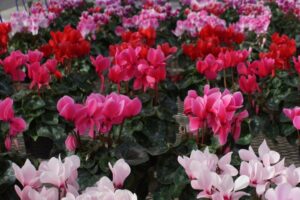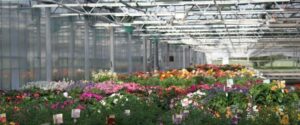
Greenhouses, AI and robots:
Time to adjust our thinking.
By John Fitzsimmons
Reviewing recent developments in horticulture, and in particular in greenhouse production, is a regular process for growers and specialist media. But with the rapid emergence and development of technologies like Artificial Intelligence (AI), sensory capabilities and robotics, it is time to look beyond hardware and even services and consider more holistically what our growing business needs and wants are.
We have recently observed in a ‘careers and employment’ context that horticulture no longer seeks or prioritises skills training of the traditional kind. People who know ‘how to grow’ are not necessarily the primary employment targets. Instead there is a growing demand for people from hugely diverse scientific and technical backgrounds to fill roles not even recognised last year, or the year before, in our industry. Chemometrics or Digital Plant Phenotyping anyone? Above enterprise level, these sectors need people with high level mathematics, chemistry, electronics and physics training, knowledge and understanding.
There’s still a need and a place for the ‘green thumbs’ but they’re not necessarily on the steering wheel any more. Take the people at Dutch company Gearbox as examples – their profiles on the company website tell an interesting story:
- Johan is a ‘camera expert’ and ‘robot whisperer’
- Julian is an ‘AI hero and machine learning engineer with a hands-on mentality’
- Kjell is a ‘3D printer expert and plasma cutter’
- Lindy is an ‘image scanner, AI trainer and visual quality control specialist
- Britt is ‘a data translator and smart processes’ specialist
- Others are ‘code crackers’, electrical engineers and ‘robotic arm connoisseur’. The company seeks ‘full stack developers’ and ‘front-end makers’.
No, we haven’t lost sight of our story’s headline, or that Hort Journal is for the greenlife industry. Gearbox Innovations was one of many tech companies involved in this year’s Green Expo in Amsterdam (NL) at a forum discussing the future of AI and robotics in greenhouse horticulture. Gearbox ‘provides the employers of the future with digital tools … vision and cameras are at the core of the company’ …. (specialising in) ‘robotics and data-driven growing’.
The forum revealed that it’s how we think about our enterprises, our working activities, our approaches to problem solving and our future sustainability that is more important than just choosing or upgrading some equipment. The way horticulture’s traditional supply and service companies are now mutating and collaborating has also changed significantly. For example, well known Dutch technology company Priva, and Belgian R&D group Octinion announced a merger in 2021, after which the horticultural robotics activities were first continued under the Priva Kompano flag. Last year a new brand, Octiva, combining Octinion and Priva was announced.
Green Expo also saw a move to greater collaboration between the Netherlands and Japan – bringing world leading growing knowledge and renowned technology enterprises together as collaborators not competitors. As one panellist commented: ‘If two parties sit down and are clear on what they can or cannot do, and do or do not want, they can find agreement. But if two parties sit down with both wanting everything they will never agree’.
This comment was part of extensive discussions about how to progress technical developments as fast as possible, efficiently, and harmoniously.

For example, observations were made comparing the (mainly US-based) tech industries who rush headlong into change and worry about the social or environmental ramifications later, versus the usually more conservative Dutch approach which considers such matters at the beginning of technical developments.
Typically, Octiva pointed out their aim was to create the right concept, prototype that concept and take the first series to market, but “it’s essential to know it’s right”. Octiva also highlighted the need to quickly develop high product volumes in the market to be cost-efficient.
While there are still relatively small numbers of robots in horticulture Octiva believes that reflects a greater need to have “the right hardware at the right price point – it must be cost-efficient to compete with humans”.
That’s why Octiva has positioned itself as ‘a platform company helping others’.
“We don’t expect every company to become a hardware company. We are working on a mobility platform, a cloud platform, a robot arm platform. So we say to others you are really good at vision, at software – put it on our platform and into our global sales channels and a support an organisation that has been around for 60 years. That’s how we can get to market really fast”. They are working with ‘an ecosystem of ideas’. Octiva believes this approach reduces the cost of support while still allowing for innovation. This sounds much like the divergent approaches taken to personal computing by Microsoft/PCs and Apple years ago.
Time was also a factor frequently discussed. It was suggested that too much (industry?) funding is being directed to ‘solutions we might need five or ten years away. Let’s focus on today’.
It was in this vein that the CEO of Dutch company Royal Brinkman focused on sustainability; rather than just aiming to sell a product, they now focus on “asking what we can do to help you (growers) on a higher level of discussion with your sustainability issues – with customers and industry partners”.
Energy is still a hot topic in Europe but Dutch greenhouse growers report quickly finding ways to sustain production with 25% less gas. Yet there is still a lot of improvement needed in ‘the total subject of waste management – especially of biodegradable substrates’.
The growth of protected cropping and production systems is expected to continue to boom as land space, globally, becomes more limited. Land use is the key to biodiversity and mitigating climate change. One Green Expo panellist pointed out there is more CO2 in the world’s atmosphere due to land use change, than is due to oil and gas!?

Data, data, data
Much has been said and written about AI and the need for data. Yes, AI functions and thrives on more data. However, as Japanese panellists pointed out, data is not the final goal so it is not important. “Data leads to knowledge. Knowledge leads to wisdom. We need wisdom. It is important how we use the data collected.”
Enabling technologies contributes to solutions to problems and challenges.
The rapidly developing robotics sector will help to reduce or eliminate labour, especially where labour supply is limiting. Elon Musk’s recent comments about ‘no jobs’ are a warning: “We are seeing the most disruptive force in history here. There will come a point where no job is needed – you can have a job if you want one for personal satisfaction but AI will do everything.” Robotics will also make work safer, more comfortable and more appealing to new people to the industry. Forum participant Yanmar of Japan has changed from a traditional diesel-and-machinery company to a technology player. But its decades-long contact with its farmer-customers is driving its tech development to meet their contemporary needs – an ageing, costly and shrinking workforce being prominent.
Dutch company Ridder has now employed AI and 3D vision systems and an advanced algorithm (GroW) in automated fruit harvesting that ‘becomes smarter with every cut’. It is used in the first robot with two arms that enables simultaneous harvesting of both sides of a crop row.
“Robotisation and AI are the missing links today in making growing autonomous.” Robotisation makes things ‘hands free’ while AI should also capture the knowledge of growers.” We need to find a way to capture the knowledge of long-term growers into algorithms and apply those algorithms to maximise the (desired) result.
Even the Japanese delegates conceded ‘there is not yet a perfect robot’ capable of multiple tasks.
“The robot always collaborates with human creativity.”
Speakers also said it was important to realise that it is not just developing a robot and putting it to work in the greenhouse; for the greenhouse, infrastructure needs to change. Sometimes that is a matter of scale but it’s sometimes it’s a matter of a rail system.
Innovations in 2023
Green Expo presented a number of technical innovations for horticulture this year including:
- BiomicAgritech: A new way of growing trellised vegetables. Plants grow downward from rotatable tubes containing substrate and irrigation. Trellising is done by gravity, and leaning and lowering is done by rotating the tubes automatically, causing the stems to wind on the tubes, saving labour.
- Agculture: Geysir is a clear float glass with a low-E coating on the outer surface of the glass along with 2xAR coatings. Thanks to the low-E coating, the heat generated is kept inside the greenhouse, resulting in around 20% reduction in the heating energy consumption. The coatings maintain the same level of PAR light compared to the normal low-iron glass.
- CE-Line BV: Celine is a real-time laboratory for all nutrients at the greenhouse itself with no manual samples and no waiting on lab results. Direct data of all nutrients gives direct control over the nutrients in the solution.
- Biobest Group NV: Scouting is the first crucial step of successful IPM. Trap-Eye™ fully automates sticky trap monitoring using a dense network of scouting devices to image sticky traps which are analysed to count both pests and beneficial insects.
- Ridder: CropView AI is an affordable and stand-alone AI-based vision technology for automated crop registration and autonomous growing.
Main photo: Quality, consistency and uniformity can be enhanced with new technologies and artificial intelligence (AI) (Image: John Fitzsimmons)
